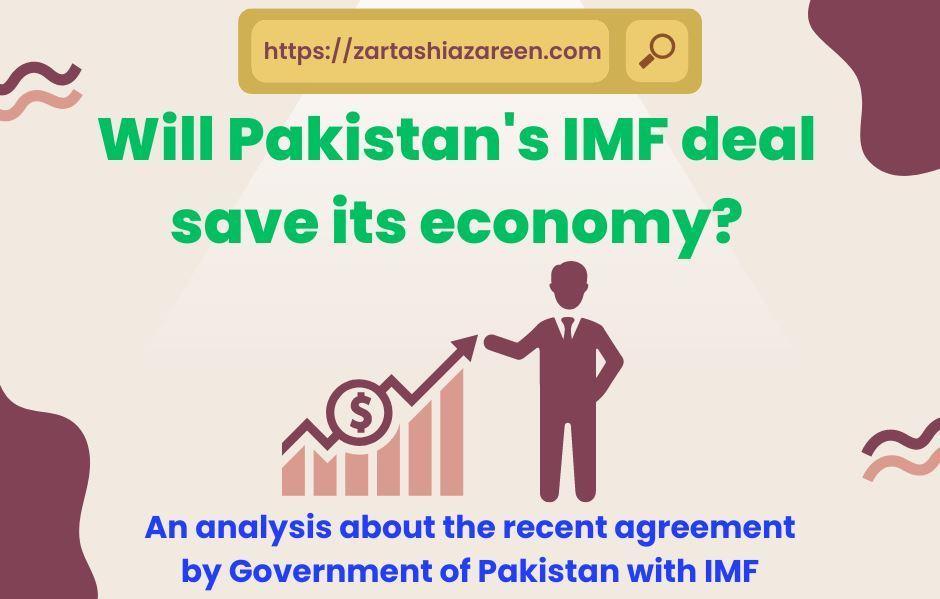Will Pakistan’s IMF deal save its economy?
Introduction:
Pakistan’s economy has faced a number of challenges in recent years, including fiscal deficits, mounting debt burdens, and currency strife. To address these critical issues, the Pakistani government approached the International Monetary Fund (IMF) for financial assistance. In this article, we will examine the details of Pakistan’s IMF agreement, its potential impact on the country’s economy, and the demographic factors that may influence its success.
IMF deal: Lifeline for Pakistan:
IMF agreement signed, 2023, providing Pakistan with a financial package of 3 billion USD to stabilize its economy. The loan aims to address immediate economic imbalances, strengthen governance and implement structural reforms to promote sustainable economic growth.
Demographic Factors Affecting IMF Agreement:
A. Population growth and job creation:
Pakistan’s rapidly growing population, estimated at 231.4 million in 2021, presents a significant challenge in terms of employment generation. The success of the IMF deal to save Pakistan’s economy depends on its ability to create employment opportunities to expand the workforce.
B. Eradication of Income Inequality and Poverty:
With a Gini coefficient, Pakistan faces high levels of income inequality. The IMF agreement should include measures to address this issue and ensure that economic growth leads to poverty reduction and improved living standards for all segments of society.
Financial Reforms and Revenue Generation:
A. Tax Reforms:
Pakistan’s tax-to-GDP ratio has been low, highlighting the need for comprehensive tax reforms. The IMF agreement should prioritize measures to broaden the tax base, increase tax collection efficiency and reduce tax evasion. These reforms will contribute to a more sustainable fiscal position.
B. Subsidy Rationalization:
The government’s subsidy programs have put significant pressure on Pakistan’s financial resources. The IMF agreement should emphasize rationalizing subsidies so that funds can be redirected to more productive sectors and social safety nets, while ensuring targeted support for vulnerable groups.
Structural reforms and economic diversification:
A. Energy Sector Reforms:
Pakistan’s energy sector faces challenges such as revolving credit, capacity constraints and inefficient distribution. The IMF agreement should focus on comprehensive reforms in the energy sector to improve the efficiency of energy production and distribution, reducing costs for businesses and households alike.
B. Export Promotion and Trade Policy:
Pakistan’s economy is heavily dependent on a few key exports, making it vulnerable to external shocks. The IMF agreement should give priority to diversifying Pakistan’s export base by promoting non-traditional sectors and improving trade policies to increase competitiveness in the global market.
Infrastructure development and investment:
A. CPEC and Chinese investment:
The China Pakistan Economic Corridor (CPEC) has the potential to accelerate economic growth and infrastructure development. The IMF agreement should take advantage of the opportunities offered by CPEC and ensure transparent and sustainable investment that will benefit Pakistan’s economy as a whole.
B. Human capital development:
Investment in human capital is critical to long-term economic growth. The IMF agreement should encourage policies that prioritize education, vocational training and health care, equipping the workforce with the skills necessary to thrive in a rapidly changing global economy.
Result:
Pakistan’s IMF deal has the potential to save its economy by addressing key macroeconomic imbalances and implementing key structural reforms. However, the success of this deal will depend on various demographic factors, including population growth, income inequality and job creation. By effectively implementing the IMF program and taking into account these demographic dynamics, Pakistan can pave the way for sustainable economic growth, poverty reduction, and improvement in the quality of life of its citizens.


Nice Article